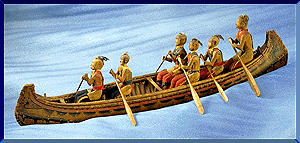 |
War Canoes
 |
Model of a decorated bark canoe with carved figures representing a war party from the Upper Great Lakes ca. 1820 CMC III-M-10 |
Painted war canoes were once a familiar sight on the Great Lakes. This metre-long model was made in about 1820 by Jean-Baptiste Assiginack, a chief of the Ottawa (Odawa) Nation, as a souvenir for Europeans. The six carved and painted wooden figures (originally seven) have distinct facial features and represent real people known to Assiginack, among them a distinguished orator, a chief and a warrior. Assiginack provided the paddlers with leggings, breechcloths, garters, sashes and feather head-dresses: one even has a tiny pair of moccasins. The canoe itself is much older than any of the Museum's full-sized bark craft. Its painted decorations on both bark cover and wooden framework are of an unusual type that is very rare in ethnographic collections.
Jean-Baptiste Assiginack, who adopted his French forename when he became a Christian, assisted the British cause in the War of 1812 and later acted as interpreter for the British Indian Department at the military outpost on Drummond Island at the northern end of Lake Huron. Born in an Ottawa village in Michigan in 1768, Assiginack died on Manitoulin Island in Georgian Bay in 1866 at the age of ninety-eight.
| kayaks | umiaks | bark canoes | dugout canoes exhibition photos | conservation | bibliography | other WWW resources credits |
 |